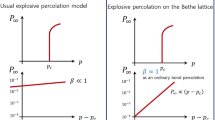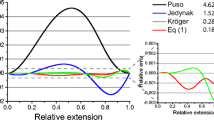Abstract
The processes of the irreversible aggregation of chain molecules with various numbers of associating groups are studied by the Monte Carlo method using the Eden model. Three-dimensional lattice systems are considered. The model developed qualitatively reproduces the main structural (morphological) characteristics that are observed experimentally for the aggregates composed of macromolecules of ionic polymers under the conditions of strong segregation. It is established that the chains with one associating terminal group form tree-like coral-shaped aggregates; associating groups form the skeleton with a large number of branches at the periphery. It is shown that the chains with the number n s ≥ 2 of associating groups form aggregates whose structures correspond to a three-dimensional network. Integral characteristics of a system are scale-invariant; molecular parameters, such as the chain length N and the number of associating groups n s, enter into corresponding scaling dependences in the form of scaling multipliers N α and n s γ. Critical indices α and γ, as well as “main” index β determining the dependence of the mean aggregate sizes on the number n of constituting molecules, are estimated. It is established that an increase in the number of associating groups in a chain results in the formation of more compact aggregates with smaller characteristic size of a network cell. For the model considered, such an effective compression is explained by the intensification of branching, i.e., by the dispersal of growth points, rather than by the folding of chains (on the contrary, their substantial fraction is attached to the cluster in greatly extended conformations). The important role of intra- and interchain screening effects arising during the formation of local morphology of aggregates is demonstrated. As a result of such screening, the sizes of lattice nodes composed of associating groups seem to be the nonmonotonic function of the number of these groups in the chain.
Similar content being viewed by others
REFERENCES
Fractals in Physics, Pietronero, L. and Tosatti, E., Eds., Amsterdam: North-Holland, 1986.
Witten, T.A. and Sander, L.M., Phys. Rev. Lett., 1981, vol. 47,no. 12, p. 1400.
Witten, T.A. and Sander, L.M., Phys. Rev., 1983, vol. 27,no. 2, p. 586.
Kinetics of Aggregation and Gelation, Family, F. and Landau, D.P., Eds., Amsterdam: North-Holland, 1984.
Eden, M., Proceedings of the Fourth Berkley Symposium on Mathematical Statistics and Probability, Neyman, F., Ed., Berkley: Univ. of California, 1961, vol. 4, p. 223.
Flory, P.J., Principles of Polymer Chemistry, Ithaca: Cornell Univ. Press, 1953.
Micellization, Solubilization, and Microemulsions, Mittal, K.L., Ed., New York: Plenum, 1977, vols. 1, 2.
Holliday, L., Ionic Polymers, New York: Halstead, 1975.
Eisenberg, A. and King, M., Ion-Containing Polymers, New York: Academic, 1977.
Goethals, E.J., Telechelic Polymers: Synthesis and Applications, Boca Raton: CRC Press, 1989.
Nyrkova, I.A., Khokhlov, A.R., and Doi, M., Macromolecules, 1993, vol. 26,no. 9, p. 3601.
Chakarabarti, A. and Toral, R., J. Chem. Phys., 1989, vol. 91,no. 11, p. 5687.
Verdier, P.H. and Stockmayer, W.H., J. Chem. Phys., 1962, vol. 36,no. 1, p. 227.
Hilhorst, H.J. and Deutch, J.M., J. Chem. Phys., 1975, vol. 63,no. 11, p. 5153.
Baumgartner, A., Applications of the Monte Carlo Method in Statistical Physics, Binder, K., Ed., Berlin: Springer, 1984, p. 145.
Khalatur, P.G., Pletneva, S.G., and Marchenko, G.N., Russ. Chem. Rev., 1986, vol. 55,no. 4, p. 357.
Balazs, C., Karasz, F.E., and MacKnight, W.J., Cell Biophys., 1987, vol. 11,no. 1, p. 91.
Carmesin, I. and Kremer, K., Macromolecules, 1988, vol. 21,no. 11, p. 2819.
Khalatur, P.G., Men'shikova, L.V., and Khokhlov, A.R., Macromol. Theory Simul., 1997, vol. 6,no. 3, p. 317.
De Gennes, P.-G., Scaling Concepts in Polymer Physics, Ithaca: Cornell Univ. Press, 1979.
Author information
Authors and Affiliations
Rights and permissions
About this article
Cite this article
Kovalenko, Y.N., Mologin, D.A. & Khalatur, P.G. Simulation of the Processes of Irreversible Aggregation in the Systems of Molecular Chains with Different Distribution of Associating Groups. Colloid Journal 62, 721–730 (2000). https://doi.org/10.1023/A:1026630809095
Issue Date:
DOI: https://doi.org/10.1023/A:1026630809095




